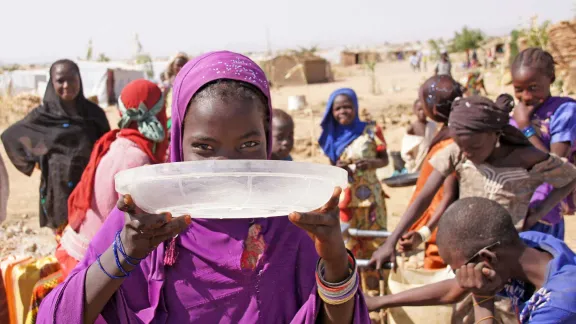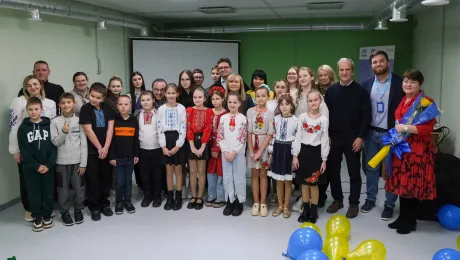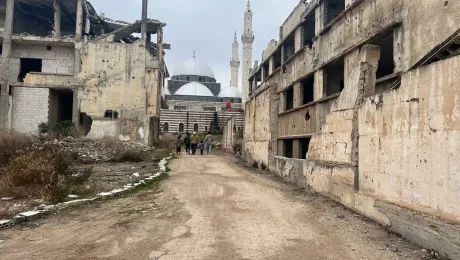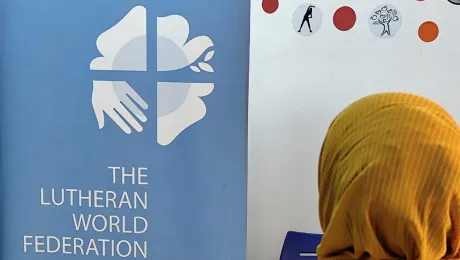
Children play at one of the water collection tanks between the Mailoti river and Minawao refugee camp. Photos: LWF/ C. Kästner
LWF provides safe drinking water for Boko Haram refugees in Cameroon
(LWI) - Twenty liters - this is the recommended minimum amount of clean water every person should have at their disposal every day. What seems like quite a restriction for people living in developed countries, is more of a challenge in arid areas, especially if lots of people are living in very little space, as is the case in most refugee camps. Provision of safe drinking water and sanitation is one of the many ways the Lutheran World Federation (LWF) supports refugees, for example in Minawao camp, northern Cameroon.

Minawao used to be covered with bush and trees, nourished by a seasonal river nearby. When Boko Haram started attacking villages in the Lake Chad region in neighboring Nigeria, people fled to northern Cameroon. In 2012 Minawao was established, a refugee settlement of 60,000 inhabitants.

Within weeks, demand for water had multiplied exponentially. “We used to walk to the river for water,” Aisha Bakar, one of the refugees, says. “It was a two-hour walk there, and another two hours back.” The women made the long journey twice a day, carrying as many jerry cans as they could. The water was dirty, water-borne diseases such as diarrhea and cholera were common in the camp.

We used to walk to the river for water. It was a two-hour walk there, and another two hours back. Now it is closer to our homes, we can go when we need water and the children don’t get sick anymore.
Today, Bakar has a tapstand only a few minutes from her home. She manages to fetch water more than twice a day and has a lighter load. What’s more, her children don’t get sick anymore. “The water is close, I can get some when I need it,” she says. “Our health has improved a lot.”

LWF has bridged the long walk from the Mailoti river to Minawao refugee settlement with pipes and collection tanks. Water is taken from the riverbed in the rainy season or a specially dug hole in the dry season and pumped up to the first collection tank.

So-called onion tanks are named after the elliptic shape they take when filled with water. From the first collection point, the water is pumped uphill to the pumping station, where the main quality checks are performed.

Yacoubou Philibbos was a student of biology and geography, before he had to flee in 2013. He saw houses and churches burn and his friends die. In Minawao, he could not continue his studies, so he applied to be trained as an engineer. Together with his colleague Saidu Kaigama, the two men test the water from the river and add the necessary chemicals for purification, before sending it onwards, through kilometers of black pipes, to the water tank near the camp.

The final water check is performed by Ezra Naulaha, another engineer trained by LWF. Every morning he arrives at 6am at the water tank, consisting of two big green bladders under a sun protection roof. He controls the water quality, before releasing it to the taps, where women and children fill their jerry cans.

The two water bladders in his charge contain 10,000 liters each. Between four and ten bladders are needed on an average day. Naulaha analyses the water quality every few hours. If the quality does not meet standards, he adds chlorine and the tap stays closed until the quality has improved.

At the tap stand, predominantly women and girls wait to fill their jerry cans to cook and wash for the families.

Many young boys need the water for a different trade: they are making bricks to build more permanent houses. Having lived under plastic sheets for years, many long for the feeling of safety a more permanent shelter can provide, even if they hope it will only be for a short time.
The primary installation of the water pipe system was supported by Norwegian Church Aid (NCA) and the Norwegian Ministry of Foreign Affairs.
Text and images: LWF/ C. Kästner


